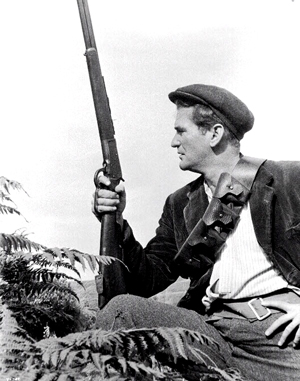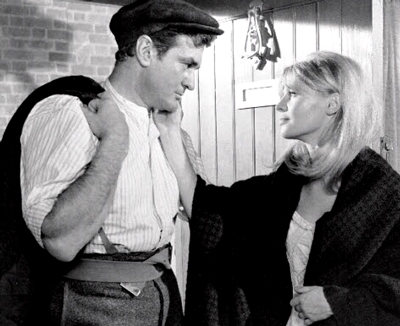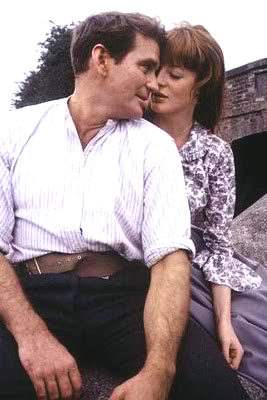
 |
|
|
|
The chemistry in the 1965 MGM film Young Cassidy couldn't be bettered. Director John Ford was always interested in Ireland as a film subject, and Sean O'Casey is a natural for him -- a pioneering Irish poet and playwright who experienced the first of the 20th century Irish Nationalist uprisings before the formation of the IRA. The young man had a rough life, watching family members die and his friends imprisoned. In the early 1920s he established himself as a controversial figure, a writer of naturalistic plays that depicted prostitution and criticized rebel heroes. The Irish carriage trade denied the existence of the first and expected sentimental treatment of the latter. When The Plough and the Stars inspired riots in the Abbey Theater, Sean became a writer for good. Ford once again had the pleasure of drawing upon his favorite Irish actors, such as the incomparable Jack MacGowran. The casting of the stars is interesting but haphazard. A busy MGM star, Australian Rod Taylor was fast becoming a tough action-man hero; yet he could also convince audiences that he might write poetry. Newly minted star Julie Christie and the promising Maggie Smith aren't given enough time in John Whiting's screenplay. Ms. Christie's part simply isn't big enough. 
Young Cassidy had barely begun filming when John Ford fell ill, as had happened on more than one film since the early 1950s. His replacement was the efficient, artistically minded Jack Cardiff, who may have been attached by an insurance company. The filming proceeded from Ford's blueprints. The storyline emphasizes Sean O'Casey's (a.k.a. John Cassidy's) early involvement in the 1916 uprisings, and his experience with the Abbey Theater. A day laborer, John Cassidy (Rod Taylor) sees his mother (Flora Robson), his sister and his nephews suffer for lack of work. His brother Archie (Jack MacGowran) is an actor and contributes little. John is enlisted to write propaganda pamphlets for the nationalist cause. Participating in a riot during a strike, he meets the kept woman Daisy Battles (Julie Christie) and they begin an off-on affair. While stealing books at a local store, he forms a deeper relationship with the timid but charming Nora (Maggie Smith). John joins the fledgling pre-IRA movement and objects to their intention of confronting the British like a conventional army, wearing uniforms. The rebels are routed, with many killed and many others jailed, and John considers his days as a fighter finished. His first play attracts the attention of W.B. Yeats, the director of the prestigious Abbey Theater. Yeats (Michael Redgrave) and his wife Lady Gregory (Edith Evans) support Cassidy through a weak initial public reception. During the famous 'audience riot' that greeted performances of The Plough and the Stars, Yeats comes on stage to berate the local audience for their intolerance and short sightedness. But what might seem a disaster is anything but, because Cassidy's work attracts interest abroad. He asks Nora to come with him, but she is terrified of leaving Dublin. Judging from his biography Sean O'Casey was more of an organizer, pamphleteer and critic of the Irish Independence Movement, and less of the brawling tough/sensitive guy seen in Young Cassidy. Rod Taylor carries a streak of intelligence and tender concern; it's conceivable that he is a man of letters. Had John Ford directed, he might well have made the script's bar fights and spontaneous dust-ups longer and broader than did replacement director Jack Cardiff. At one point Cassidy, his brother and friends burst into a bar for a drink. They trade light insults with some field hockey players. It's clear that both groups wouldn't mind getting into a fight, just to enliven the afternoon. Cardiff winds up things pretty quickly (with John decking a policeman), but we can't help thinking that Ford would have turned the scene into a full on comic free-for-all. Cardiff compromises with the Ford style, retaining wide masters in the hovel the Cassidys call a home, and filming exteriors in a more freewheeling fashion. The crushing poverty is made clear from the first shot of Mrs. Cassidy cooking as a baby sits on a pot at her feet. Although we see John lose both his mother and his exhausted, defeated sister, the film does not drown in sentiment. John takes it all in and pushes forward. The strike riot comes early in Young Cassidy. In all of the rebel activity pictured in the film, the spirit of the cause is spoiled as soon as violence is involved. We're accustomed to seeing noble IRA fighters opposing ruthless Black 'n' Tans, or at least being asked to make an emotional commitment to the rebels, as in David Lean's Ryan's Daughter or Ford's own The Informer. The rebel politico that enlists John Cassidy in the fray, chooses to hide out in a bar until the dust clears. The righteous strikers become a murderous mob, killing the most pitiful-looking scab dray driver on record. Even Daisy Battles laughs at the carnage. When it comes to street fighting, disorganization and poor policy sees the nationalists easily routed by the Brits, professionals that know what they're doing. The treachery, torture and summary executions happen off screen, but we can see their effect on John Cassidy's face. He wants nothing more to do with armed insurrection. 
Is this John Ford's take on revolution, a growing cocktail party subject of the 1960s? Young Cassidy doesn't really establish that Sean O'Casey was all his life a confirmed socialist. When we last see him, it looks like he's still a two-fisted playwright, soon to be cracking heads in theaters in Toronto or Paris. Rod Taylor is excellent star material and carries the role and the film without a strain; it's one of his most accomplished performances. Julie Christie is provocative and saucy, but as we expect her Daisy Battles to figure more prominently we're disappointed when she vanishes from the screen. Maggie Smith is very interesting as a credible Irishwoman of 1916 but we likewise feel that her part is not fully developed, or that something is missing. The movie stays nailed to John Cassidy's forward momentum. For a short bit the most important woman seems to be W. B. Yeats' wife, Edith Evans. She infuses Cassidy with the idea that he is already an important writer with the potential to join the greats of the age. Even with the Ford-like rough stuff -- Cassidy takes a break to punch out a belligerent playgoer in the lobby of the Abbey Theater -- Young Cassidy stays firmly on track. The scenes of the audience riot are fascinating, with people pelting the actors with food and shouting: "There are no prostitutes in Ireland!" Donning a pince-nez, Michael Redgrave is a dead wringer for W.B. Yeats, whom most of us know as the author of the fearsome political poem "The Second Coming", with its rough beast slouching toward Bethlehem. Here he seems quite happy advancing Irish culture by running a progressive theater group. Young Cassidy came out in the same year, from the same studio, and featuring one of the same actresses as David Lean's Doctor Zhivago, another movie ostensibly about a man of letters. Omar Sharif's Zhivago is soulful and sensitive to the point that he sheds tears of rapture at the sight of snowflakes and falling leaves, yet all we know about his poetry is that is about 'love'. Beautiful images and music represent Zhivago's inspiration, but for all we know he's writing pornographic mash notes to Lara. In Young Cassidy we see that this socialist playwright is compelled to lay down his ideas in a dramatic form. The grimy Cassidy holes up in a corner and scribbles out his thoughts with a nub of a pencil. Cardiff and Taylor nail the guy's earthy sensitivity -- we believe that this ex-ditch digger can write. 1 
Just as Young Cassidy is reaching a satisfying peak and needs a dignified exit the strangest thing happens. As if told to cut things short, the movie has barely spoken its last important dialogue line when it simply comes to an abrupt and sloppy end. Neither the editing rhythm nor the music pay off satisfactorily, so a film that has actually arrived at a proper conclusion, doesn't seem to. What happened? An equally jolting effect curtails John Ford's last feature film, 7 Women. The picture ends on a truly dark, violent note, with everything converging on a devastating last line of dialogue from Anne Bancroft, followed by a fast fade. The audience isn't ready for this surprise finish. What's needed is at least three or four seconds of black screen, to let the shock set in before the end credits come up. 7 Women instead goes straight into a big credits music cue, smothering the dramatic impact. It's a case in which a single editing choice mutes the impression of an entire film. In its last scene Young Cassidy also seems to be reaching for a bit of a James Joyce Dubliners effect. John Cassidy asks Nora to accompany him on a grand adventure into the unknown literary future, away from Ireland on a large boat. The meek Nora can't handle the idea of leaving familiar surroundings. She lacks the courage to 'get on the boat' and take the risk of changing her life, even with John's invitation. It's very much like the powerful short story "Evaline" in Dubliners. Was this intended? Is it perhaps an artistic choice of Jack Cardiff, who introduces Eisensteinian shots into the strike riot and took as a directing assignment the daunting Sons and Lovers? We wonder if the ending of Young Cassidy seems so truncated because shots of a distressed Nora were removed as John sails away. 2 
The Warner Archive Collection DVD-R of Young Cassidy is a remastered enhanced widescreen presentation. The WAC discontinued the use of the 'remastered' banner on their product a while back because their discs are now held to a higher quality standard, and remastered if they fall short. Young Cassidy looks the best I've seen it, with better compositions in widescreen and many scenes given improved colors. The show still looks a little cold overall, and the colors don't quite pop. Not having seen the film in a new Metrocolor print, I don't know how much better it looked originally. The bottom line is that the transfer is very good, but not a thing of beauty. The original trailer doesn't seem to know how to sell the film, just like the poster with the bare-chested Rod Taylor who looks ready to wrestle a bear or ravage Julie Christie.
On a scale of Excellent, Good, Fair, and Poor,
Young Cassidy rates:
Footnotes:
1. A quote from my father, now seems wiser than when I first heard it: "Academics who can't make the grade end up digging ditches. Ditch diggers who lack skill become poets and artists." I don't think he was necessarily talking about my status as a film major.
2. This is pure guesswork and should be chalked up as Savant rewriting the movie for his own amusement and to make himself feel important. Pay no attention. 3. My thanks to correspondent Jon Paul Henry for a correction about James Joyce in the text.
Reviews on the Savant main site have additional credits information and are often updated and annotated with reader input and graphics. Also, don't forget the 2011 Savant Wish List. T'was Ever Thus.
Review Staff | About DVD Talk | Newsletter Subscribe | Join DVD Talk Forum |
| ||||||||||||||||||